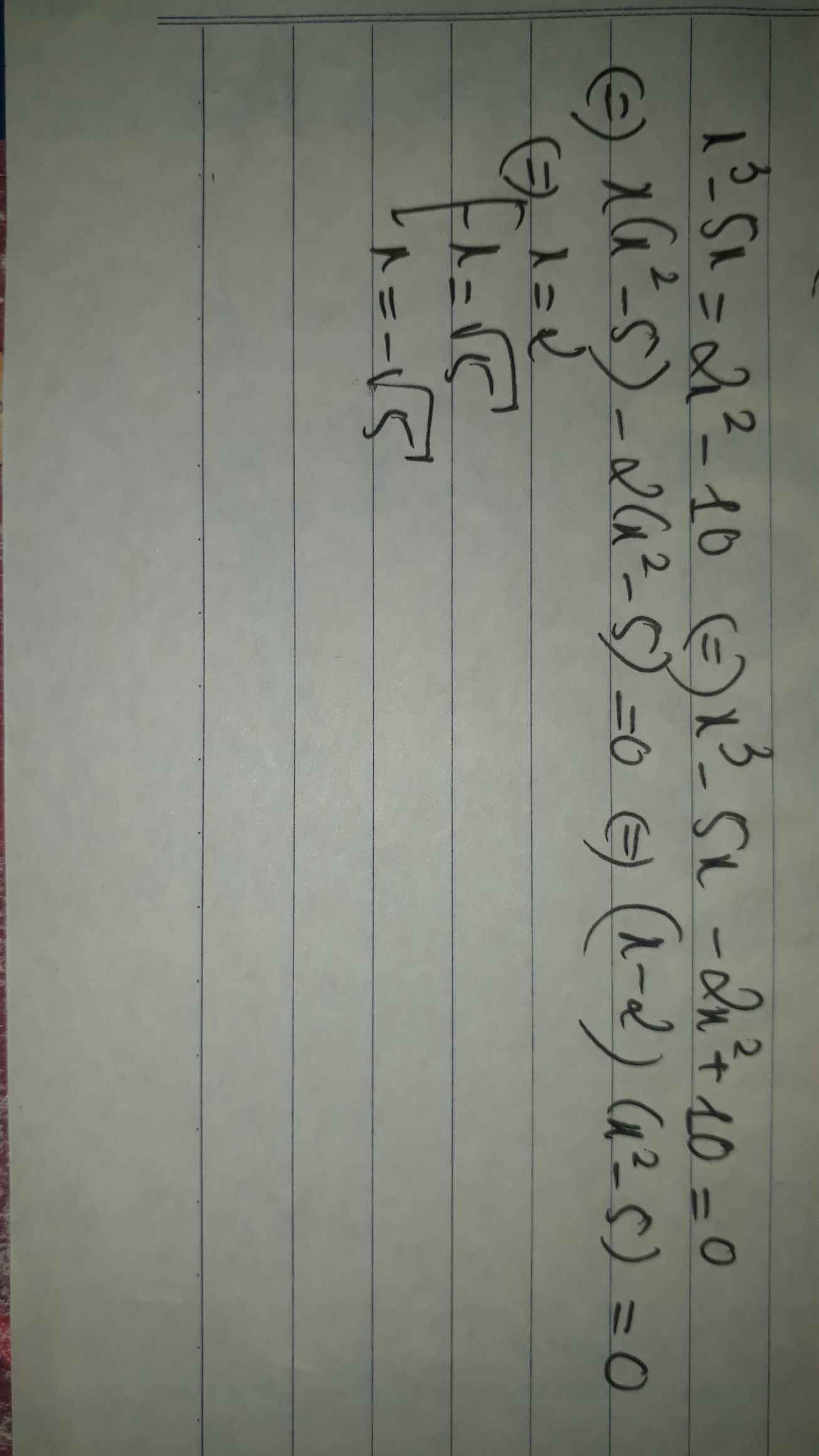cách giải phương trình 2x -3 = 10
Hãy nhập câu hỏi của bạn vào đây, nếu là tài khoản VIP, bạn sẽ được ưu tiên trả lời.


a) 3 x 2 − 7 x − 10 ⋅ 2 x 2 + ( 1 − 5 ) x + 5 − 3 = 0

+ Giải (1):
3 x 2 – 7 x – 10 = 0
Có a = 3; b = -7; c = -10
⇒ a – b + c = 0
⇒ (1) có hai nghiệm x 1 = - 1 v à x 2 = - c / a = 10 / 3 .
+ Giải (2):
2 x 2 + ( 1 - √ 5 ) x + √ 5 - 3 = 0
Có a = 2; b = 1 - √5; c = √5 - 3
⇒ a + b + c = 0
⇒ (2) có hai nghiệm:

Vậy phương trình có tập nghiệm 
b)
x 3 + 3 x 2 - 2 x - 6 = 0 ⇔ x 3 + 3 x 2 - ( 2 x + 6 ) = 0 ⇔ x 2 ( x + 3 ) - 2 ( x + 3 ) = 0 ⇔ x 2 - 2 ( x + 3 ) = 0

+ Giải (1): x 2 – 2 = 0 ⇔ x 2 = 2 ⇔ x = √2 hoặc x = -√2.
+ Giải (2): x + 3 = 0 ⇔ x = -3.
Vậy phương trình có tập nghiệm S = {-3; -√2; √2}
c)
x 2 − 1 ( 0 , 6 x + 1 ) = 0 , 6 x 2 + x ⇔ x 2 − 1 ( 0 , 6 x + 1 ) = x ⋅ ( 0 , 6 x + 1 ) ⇔ x 2 − 1 ( 0 , 6 x + 1 ) − x ( 0 , 6 x + 1 ) = 0 ⇔ ( 0 , 6 x + 1 ) x 2 − 1 − x = 0

+ Giải (1): 0,6x + 1 = 0 ⇔ 
+ Giải (2):
x 2 – x – 1 = 0
Có a = 1; b = -1; c = -1
⇒ Δ = ( - 1 ) 2 – 4 . 1 . ( - 1 ) = 5 > 0
⇒ (2) có hai nghiệm 
Vậy phương trình có tập nghiệm 
d)
x 2 + 2 x − 5 2 = x 2 − x + 5 2 ⇔ x 2 + 2 x − 5 2 − x 2 − x + 5 2 = 0 ⇔ x 2 + 2 x − 5 − x 2 − x + 5 ⋅ x 2 + 2 x − 5 + x 2 − x + 5 = 0 ⇔...

\(a,\left\{{}\begin{matrix}x+y=3\\2x-3y=1\end{matrix}\right.\\ \Leftrightarrow\left\{{}\begin{matrix}2x+2y=6\\2x-3y=1\end{matrix}\right.\\ \Leftrightarrow\left\{{}\begin{matrix}5y=5\\2x-3y=1\end{matrix}\right.\\ \Leftrightarrow\left\{{}\begin{matrix}y=1\\2x-3.1=1\end{matrix}\right.\\ \Leftrightarrow\left\{{}\begin{matrix}x=2\\y=1\end{matrix}\right.\)
Vậy \(\left(x;y\right)=\left(2;1\right)\)
b, \(x^2-7x+10=0\\ \Leftrightarrow x^2-5x-2x+10=0\\ \Leftrightarrow x\left(x-5\right)-2\left(x-5\right)=0\\ \Leftrightarrow\left(x-2\right)\left(x-5\right)=0\\ \Leftrightarrow\left[{}\begin{matrix}x-2=0\\x-5=0\end{matrix}\right.\\ \Leftrightarrow\left[{}\begin{matrix}x=2\\x=5\end{matrix}\right.\)
\(a,\)\(\left\{{}\begin{matrix}x+y=3\\2x-3y=1\end{matrix}\right.\)
\(\Leftrightarrow\left\{{}\begin{matrix}3x+3y=9\\2x-3y=1\end{matrix}\right.\)
\(\Leftrightarrow\left\{{}\begin{matrix}5x=10\\2x-3y=1\end{matrix}\right.\)
\(\Leftrightarrow\left\{{}\begin{matrix}x=2\\2.2-3y=1\end{matrix}\right.\)
\(\Leftrightarrow\left\{{}\begin{matrix}x=2\\y=1\end{matrix}\right.\)
Vậy hệ pt có nghiệm duy nhất \(\left(x;y\right)=\left(2;1\right)\)
\(b,x^2-7x+10=0\)
\(\Delta=b^2-4ac=\left(-7\right)^2-4.10=9>0\)
\(\Rightarrow\) Pt có 2 nghiệm \(x_1,x_2\)
Ta có :
\(\left\{{}\begin{matrix}x_1=\dfrac{-b+\sqrt{\Delta}}{2a}=\dfrac{7+3}{2}=5\\x_2=\dfrac{-b-\sqrt{\Delta}}{2a}=\dfrac{7-3}{2}=2\end{matrix}\right.\)
Vậy \(S=\left\{5;2\right\}\)

Bài 1:
a) Ta có: \(2\left(3-4x\right)=10-\left(2x-5\right)\)
\(\Leftrightarrow6-8x-10+2x-5=0\)
\(\Leftrightarrow-6x+11=0\)
\(\Leftrightarrow-6x=-11\)
hay \(x=\dfrac{11}{6}\)
b) Ta có: \(3\left(2-4x\right)=11-\left(3x-1\right)\)
\(\Leftrightarrow6-12x-11+3x-1=0\)
\(\Leftrightarrow-9x-6=0\)
\(\Leftrightarrow-9x=6\)
hay \(x=-\dfrac{2}{3}\)

\(\dfrac{2x-1}{5}-\dfrac{4x}{3}=2x-\dfrac{x}{10}\\ \Leftrightarrow\dfrac{6\left(2x-1\right)}{30}-\dfrac{40x}{30}=\dfrac{60x}{30}-\dfrac{3x}{30}\\ \Leftrightarrow12x-6-40x=60x-3x\\ \Leftrightarrow-28x-6=57x\\ \Leftrightarrow57x+28x+6=0\\ \Leftrightarrow85x=-6\\ \Leftrightarrow x=-\dfrac{6}{85}\)

3 | 2x - 1 | < 2x + 1 ( 1 )
- xét khoảng x < \(\frac{1}{2}\), ( 1 ) có dạng :
3 ( 1 - 2x ) < 2x + 1 \(\Leftrightarrow\)-8x < -2 \(\Leftrightarrow\)x > \(\frac{1}{4}\)
vậy nghiệm của BPT khoảng này là \(\frac{1}{4}\)< x < \(\frac{1}{2}\)
- xét khoảng x \(\ge\)\(\frac{1}{2}\), ( 1 ) có dạng :
3 ( 2x - 1 ) < 2x + 1 \(\Leftrightarrow\)4x < 4 \(\Leftrightarrow\)x < 1
vậy nghiệm của BPT khoảng này là \(\frac{1}{2}\)\(\le\)x < 1
tóm lại, nghiệm của BPT đã cho là \(\frac{1}{4}< x< 1\)
à quên, 2 cách nhỉ
3 | 2x - 1 | < 2x + 1
\(\Leftrightarrow\hept{\begin{cases}3\left(2x-1\right)>-\left(2x+1\right)\\3\left(2x-1\right)< 2x+1\end{cases}}\) \(\Leftrightarrow\hept{\begin{cases}6x-3>-2x-1\\6x-3< 2x+1\end{cases}}\)
\(\Leftrightarrow\hept{\begin{cases}8x>2\\4x< 4\end{cases}}\)\(\Leftrightarrow\hept{\begin{cases}x>\frac{1}{4}\\x< 1\end{cases}}\)\(\Leftrightarrow\frac{1}{4}< x< 1\)

10 – 4x = 2x – 3 ⇔ 10 + 3 = 2x + 4x ⇔ 13 = 6x ⇔ 6x = 13⇔ x = 
Vậy phương trình có tập nghiệm S = { }.
}.

Thực ra 2 câu đầu rất dễ nha bạn ^^!
1) x4 + 2x3 + x2 + 2x + 1 =0 <=> x3(x+2)+x(x+2)+1 = 0
<=> (x3+x)(x+2) + 1=0
1>0
=> (x3+x)(x+2) + 1=0 <=> (x3+x)(x+2) = 0
<=>\(\orbr{\begin{cases}^{x^3+x=0}\\x+2=0\end{cases}}\)<=>\(\orbr{\begin{cases}^{x\left(x^2+1\right)=0}\\x=-2\end{cases}}\) <=>\(\orbr{\begin{cases}^{x=0}\\x=-2\end{cases}}\)
b)
x3+1=\(2\sqrt[3]{2x-1}\)
<=> x^3 - 1 = 2(\(\sqrt[3]{2x-1}\) -1)
<=> (x-1)(x2+x+1) = \(\frac{4\left(x-1\right)}{\sqrt[3]{\left(2x-1\right)^2}+\sqrt[3]{2x-1}+1}\)
<=> (x-1)[(x2+x+1) - \(\frac{1}{\sqrt[3]{\left(2x-1\right)^2}+\sqrt[3]{2x-1}+1}\) ] =0
<=> x=1

a) \(3x-11=0\)
\(\Rightarrow3x=11\Rightarrow x=\dfrac{11}{3}\approx3,667\)
b) \(12+7x=0\)
\(\Rightarrow7x=-12\Rightarrow x=-\dfrac{12}{7}\approx-1,714\)
c) \(10-4x=2x-3\)
\(\Rightarrow2x+4x=10+3\Rightarrow6x=13\Rightarrow x=\dfrac{13}{6}\approx2,167\)

\(x^3-5x=2x^2-10\)
\(\Leftrightarrow x^3-2x^2-5x+10=0\)
\(\Leftrightarrow x^2\left(x-2\right)-5\left(x-2\right)=0\)
\(\Leftrightarrow\left(x-2\right)\left(x^2-5\right)=0\)
\(\Leftrightarrow\left[{}\begin{matrix}x-2=0\\x^2-5=0\end{matrix}\right.\) \(\Leftrightarrow\left[{}\begin{matrix}x=2\\x=\pm\sqrt{5}\end{matrix}\right.\)

(2x + 1)(3x – 2) = (5x – 8)(2x + 1)
⇔ (2x + 1)(3x – 2) – (5x – 8)(2x + 1) = 0
⇔ (2x + 1).[(3x – 2) – (5x – 8)] = 0
⇔ (2x + 1).(3x – 2 – 5x + 8) = 0
⇔ (2x + 1)(6 – 2x) = 0
⇔ 2x + 1 = 0 hoặc 6 – 2x = 0
+ 2x + 1 = 0 ⇔ 2x = -1 ⇔ x = -1/2.
+ 6 – 2x = 0 ⇔ 6 = 2x ⇔ x = 3.
Vậy phương trình có tập nghiệm 

\(2x-3=10\)
\(2x=10+3\)
\(2x=13\)
\(x=13\colon2=6,5\)
\(2x-3=10\)
\(2x=10+3\)
\(2x=13\)
\(x=13\colon2=6,5\)